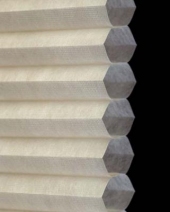Helpful information about window blinds, verticals, sheer verticals, wood blinds, roller blinds, blackout shades, roman shades and other window coverings.
Wednesday, April 21, 2010
Reducing Heat Loss with Cellular Blinds
It has been pounded into your head time after time: the cheapest way to reduce heating and cooling bills is to stop heat transfer through your windows. There are several steps you can take to increase the energy efficiency of your windows. Blinds and blind coverings are an easy way to start, and are usually cheaper than buying new windows.
One step you can take is fitted window coverings. Remember, air insulates just as well as high tech materials. Energy saving window coverings and cellular blinds create a insulating layer of dead air. Without the coverings you can get a draft around your high tech cellular shades.
The Energy Star sticker is a good way to determine if your windows are energy efficient. Window blinds can be just as effective, however window coverings are not eligible for the Energy Star program. Cellular and other window blinds are measured on the R-system of insulating value. The average curtain or blind has only a value of R-1. Honeycomb or cellular blinds with an insulating lining can have a value as large as R-6. Cutting thick foam around the window frame also increases R-value, but eventually this will come in conflict with your honeycomb insulating blinds.
Awnings and overhangs also increase energy savings by keeping sun rays from striking the window directly.
Color is also important when it comes to insulating window blinds. Light colors reflect and keep sunlight out of the home. Always remember, increasing the layers of insulation between the home and the outside is the key to energy savings through efficient window coverings. Minimize gaps between cellular shades and the wall, and maximize the number of layers and liners to keep airflow out. Cellular honeycomb window blinds do not regulate sunlight like venetian blinds, but they offer considerable advantages. Cellular blinds have a double or triple layer of material that folds up, but creates little air honeycomb pockets when extended. These air pockets are lightweight and make the honeycomb blind much more insulating by weight than any solid material. It is like adding an extra layer of double pane windows in terms of savings.
Conventional blinds do not block heat loss more than 10% so remember to use special energy efficient blinds like honeycomb blinds when trying to reduce your electric bill. The closed weave design prevents any airflow. White will reflect the most light. Medium colored cellular blinds let in a warm colored sunlight while still reflecting some heat. You could even get a black cellular window blind treatment for the winter to absorb sun rays for heat. A conventional blind can attempt to compete with custom cellular blinds by reducing all gaps for airflow.
It is important to take into consideration not only the window and window treatments by themselves, but also where they are in the house, and how much sunlight they receive. West facing windows will receive the hottest light so it might be a good idea to use high performance cellular blinds to block out the light. South facing windows provide good natural light without too much glare. Some sort of energy saving window blind that still regulates light is useful here. Remember, you can mix and match honeycomb blinds with drapes and reflective glass and blind coverings.
Subscribe to:
Post Comments (Atom)

You can reduce heat loss with cellular blinds. The post is very useful
ReplyDeleteBlinds